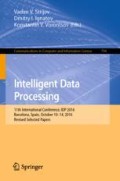Abstract
In this paper, the problem of image segmentation quality is considered. The main idea is to find a quality criterion, which could have an extremum. The problem is viewed as selecting the best segmentation from a set of images generated by segmentation algorithm at different parameter values. We propose to use information redundancy measure as a criterion for optimizing segmentation quality. The method for constructing the redundancy measure provides criterion with extremal properties. To show efficiency of the proposed criterion, computing experiment is carried out. The proposed criterion is combined with SLIC and EDISON segmentation algorithms. Computing experiment shows that the segmented image corresponding to a minimum of redundancy measure produces acceptable information distance when compared with the original image. In most cases, the lowest information distance between this segmented image and ground-truth segmentations is obtained. An example of applying the redundancy measure to segmentation of images of painting material cross-sections is considered.
Access this chapter
Tax calculation will be finalised at checkout
Purchases are for personal use only
References
Achanta, R., Shaji, A., Smith, K., Lucchi, A., Fua, P., Süsstrunk, S.: Slic superpixels. Technical report (2010)
Achanta, R., Shaji, A., Smith, K., Lucchi, A., Fua, P., Süsstrunk, S.: Slic superpixels compared to state-of-the-art superpixel methods. IEEE Trans. Pattern Anal. Mach. Intell. 34(11), 2274–2282 (2012). https://doi.org/10.1109/tpami.2012.120
Ana, L.N.F., Jain, A.K.: Robust data clustering. In: 2003 Proceedings of IEEE Computer Society Conference on Computer Vision and Pattern Recognition, vol. 2, pp. 128–133. IEEE (2003). https://doi.org/10.1109/cvpr.2003.1211462
Arbelaez, P., Maire, M., Fowlkes, C., Malik, J.: Contour detection and hierarchical image segmentation. IEEE Trans. Pattern Anal. Mach. Intell. 33(5), 898–916 (2011). https://doi.org/10.1109/tpami.2010.161
Atick, J.J., Redlich, A.N.: Towards a theory of early visual processing. Neural Comput. 2(3), 308–320 (1990). https://doi.org/10.1162/neco.1990.2.3.308
Barlow, H.B.: Possible principles underlying the transformations of sensory messages. Sens. Commun., 217–234 (1961). https://doi.org/10.7551/mitpress/9780262518420.003.0013
Beneš, M., Zitová, B., Hradilová, J., Hradil, D.: Image processing in material analyses of artworks. In: Proceedings of International Conference on Computer Vision Theory and Applications (VISAPP), pp. 521–524 (2008). https://doi.org/10.5220/0001079705210524
Christoudias, C.M., Georgescu, B., Meer, P.: Synergism in low level vision. In: 16th International Conference on Pattern Recognition, ICPR 2002, Quebec, Canada, 11–15 August 2002, pp. 150–155 (2002). https://doi.org/10.1109/ICPR.2002.1047421
Comaniciu, D., Meer, P.: Mean shift: a robust approach toward feature space analysis. IEEE Trans. Pattern Anal. Mach. Intell. 24(5), 603–619 (2002). https://doi.org/10.1109/34.1000236
Csurka, G., Larlus, D., Perronnin, F., Meylan, F.: What is a good evaluation measure for semantic segmentation? In: BMVC, vol. 27, pp. 32.1–32.11 (2013). https://doi.org/10.5244/c.27.32
Felzenszwalb, P.F., Huttenlocher, D.P.: Efficient graph-based image segmentation. Int. J. Comput. Vision 59(2), 167–181 (2004). https://doi.org/10.1023/B:VISI.0000022288.19776.77
Fowlkes, E.B., Mallows, C.L.: A method for comparing two hierarchical clusterings. J. Am. Stat. Assoc. 78(383), 553–569 (1983). https://doi.org/10.1080/01621459.1983.10478008
Frosio, I., Ratner, E.R.: Adaptive segmentation based on a learned quality metric. In: VISAPP 2015, vol. 1, pp. 283–292 (2015). https://doi.org/10.5220/0005257202830292
Gonzalez, R.C., Woods, R.E.: Digital Image Processing. Pearson Prentice Hall, Upper Saddle River (2008)
Haindl, M., Mikeš, S., Pudil, P.: Unsupervised hierarchical weighted multi-segmenter. In: Benediktsson, J.A., Kittler, J., Roli, F. (eds.) MCS 2009. LNCS, vol. 5519, pp. 272–282. Springer, Heidelberg (2009). https://doi.org/10.1007/978-3-642-02326-2_28
Haralick, R.M., Shapiro, L.G.: Image segmentation techniques. Comput. Vis. Graph. Image Process. 29(1), 100–132 (1985). https://doi.org/10.1016/s0734-189x(85)90153-7
Haykin, S.: Neural Networks: A Comprehensive Foundation, 2nd edn. Prentice Hall PTR, Upper Saddle River (1998)
Kaspar, R., Petru, L., Zitová, B., Flusser, J., Hradilova, J.: Microscopic cross-sections of old artworks. In: 2005 IEEE International Conference on Image Processing, ICIP 2005, vol. 2, pp. II-578. IEEE (2005). https://doi.org/10.1109/icip.2005.1530121
Martin, D., Fowlkes, C., Tal, D., Malik, J.: A database of human segmented natural images and its application to evaluating segmentation algorithms and measuring ecological statistics. In: 2001 Proceedings of Eighth IEEE International Conference on Computer Vision, ICCV 2001, vol. 2, pp. 416–423. IEEE (2001). https://doi.org/10.1109/iccv.2001.937655
Martin, D.R., Fowlkes, C.C., Malik, J.: Learning to detect natural image boundaries using local brightness, color, and texture cues. IEEE Trans. Pattern Anal. Mach. Intell. 26(5), 530–549 (2004). https://doi.org/10.1109/tpami.2004.1273918
Meer, P., Georgescu, B.: Edge detection with embedded confidence. IEEE Trans. Pattern Anal. Mach. Intell. 23(12), 1351–1365 (2001). https://doi.org/10.1109/34.977560
Meilă, M.: Comparing clusterings by the variation of information. In: Schölkopf, B., Warmuth, M.K. (eds.) COLT-Kernel 2003. LNCS (LNAI), vol. 2777, pp. 173–187. Springer, Heidelberg (2003). https://doi.org/10.1007/978-3-540-45167-9_14
Meilă, M.: Comparing clusterings: an axiomatic view. In: Proceedings of the 22nd International Conference on Machine Learning, pp. 577–584. ACM (2005). https://doi.org/10.1145/1102351.1102424
Rand, W.M.: Objective criteria for the evaluation of clustering methods. J. Am. Stat. Assoc. 66(336), 846–850 (1971). https://doi.org/10.2307/2284239
Unnikrishnan, R., Pantofaru, C., Hebert, M.: A measure for objective evaluation of image segmentation algorithms. In: Proceedings of the 2005 IEEE Computer Society Conference on Computer Vision and Pattern Recognition (CVPR 2005) - Workshops, CVPR 2005, vol. 03, pp. 34–41. IEEE Computer Society, Washington, DC (2005). https://doi.org/10.1109/CVPR.2005.390
Wagner, S., Wagner, D.: Comparing clusterings - an overview. Technical report 2006–04, Universität Karlsruhe (TH) (2007)
Zhang, H., Fritts, J.E., Goldman, S.A.: Image segmentation evaluation: a survey of unsupervised methods. Comput. Vis. Image Underst. 110(2), 260–280 (2008). https://doi.org/10.1016/j.cviu.2007.08.003
Zitová, B., Beneš, M., Hradilová, J., Hradil, D.: Analysis of painting materials on multimodal microscopic level. In: IS&T/SPIE Electronic Imaging, pp. 75,310F–1–75,310F–9. International Society for Optics and Photonics (2010). https://doi.org/10.1117/12.838872
Acknowledgements
The research was supported in part by the Russian Foundation for Basic Research (grants No. 18-07-01385 and No. 18-07-01231).
Author information
Authors and Affiliations
Corresponding author
Editor information
Editors and Affiliations
Rights and permissions
Copyright information
© 2019 Springer Nature Switzerland AG
About this paper
Cite this paper
Murashov, D. (2019). Application of Information Redundancy Measure To Image Segmentation. In: Strijov, V., Ignatov, D., Vorontsov, K. (eds) Intelligent Data Processing. IDP 2016. Communications in Computer and Information Science, vol 794. Springer, Cham. https://doi.org/10.1007/978-3-030-35400-8_9
Download citation
DOI: https://doi.org/10.1007/978-3-030-35400-8_9
Published:
Publisher Name: Springer, Cham
Print ISBN: 978-3-030-35399-5
Online ISBN: 978-3-030-35400-8
eBook Packages: Computer ScienceComputer Science (R0)

